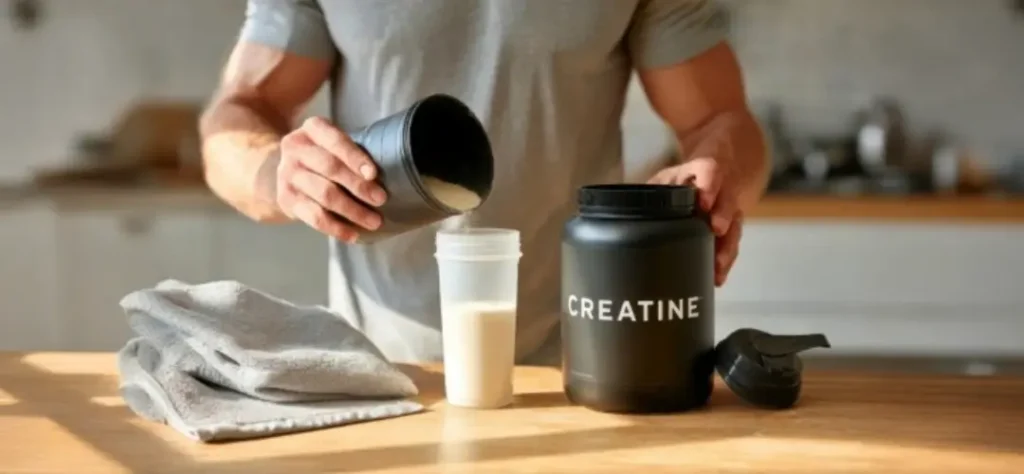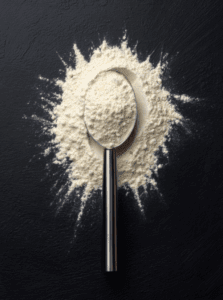
Creatine, the most studied and underrated supplement in the world
What is creatine?
La creatine is a naturally occurring nitrogen compound in the human body that is crucial for the formation of cellular energy, especially during intense, short and repeated exertion.
It is synthesized from 3 amino acids:
- Arginine
- Methionine
- Glycine
This occurs mainly in the liver, kidneys, and pancreas.
La creatine is then released into the bloodstream and then transported to tissues with high energy demand.
Where is creatine found in our body?
- 95% of creatine is stored in skeletal muscles
- The remaining 5% is found in tissues with high energy requirements:
-
-
- Brain
- Heart
- Retina
- Kidneys
- Testicles
-

Why is creatine so important?
La creatine Plays a key role in the alactacid anaerobic energy system:
During moments of rest, creatine is converted to phosphocreatine by the energy provided by aerobic metabolism
In situations of explosive effort (such as sprinting, weight lifting, jumping), phosphocreatine rapidly donates a phosphate group to ADP->converting it into ATP, the main energy molecule in our body.
This process:
-
- It is instantaneous
- Does not require oxygen
- Covers the first 5-10 seconds of a maximal effort
✅ Increased availability of creatine and thus phosphocreatine means:
-
- More energy available during critical moments
- Less early fatigue
- Faster recovery between sets
Why is it said that creatine is the most studied supplement in the world?
Creatine monohydrate is considered by many sports researchers and physicians to be the "gold standard" (=reference standard) of supplements for improving athletic performance.
To date:
- There are more than 680 studies Peer-reviewed clinic on the interaction of creatine
- Also considering in-vitro and pre-clinical studies, clinical trials, meta-analyses, and review analyses exceed one thousand scientific publications on creatine
- Including hundreds of RCTs (randomized controlled trials), i.e., randomized controlled trials, which are considered the highest level of scientific evidence to evaluate real effects and isolate variables
- Some studies have duration of more than 5 years
- Other studies analyze doses of up to 30g per day, free of side effects, at least in the short term
https://www.frontiersin.org/journals/nutrition/articles/10.3389/fnut.2024.1424972/full?
https://www.frontiersin.org/journals/nutrition/articles/10.3389/fnut.2025.1578564/full?
Creatine is one of the very few supplements officially recognized by the:
- ISSN (international society of sports and nutrition)
- It is also one of the very few supplements whose efficacy and safety profile has been recognized by top clinical institutions such as the:
-
-
- Mayo clinic (https://www.mayoclinic.org/drugs-supplements-creatine/art-20347591?)
- Cleveland clinic (https://my.clevelandclinic.org/health/treatments/17674-creatine?)
-
Documented benefits of creatine on physical performance
✅ Increased muscle strength and increased explosive power
- As mentioned above, creatine increases phosphocreatine reserves in muscles, which are used to generate ATP at times of maximum exertion
- Result: increased force production in explosive movements such as Short sprints, jumping, repeated acceleration and heavy lifting
- Document benefits in:
-
- Athletics (sprinting, jumping)
- Rugby, Basketball, American Football, Soccer
- Martial arts and combat sports
- Weight lifting (power lifting and bodybuilding)
✅ Increased training volume and intensity
- Allowing for regenerate ATP reserves faster between sets, creatine allows you to sustain:
-
-
- More repetitions
- More series
- At higher loads
-
- This results in increased muscle stimulation and thus accelerated physical performance in the long term
✅ Reduction of muscle fatigue
- Improves ability to buffer muscle acidity
- Slows down ATP depletion
- It decreases the feeling of burning during high intensity series
✅ Increased muscle hypertrophy
This is given by a combination of several factors:
- Creatine hydrates the muscle attracts water inside the muscle cell->the muscle appears fuller/swollen, thus larger
- Lifting heavier loads with higher intensity and greater total volume results in higher and more effective muscle stimulation
- Faster regeneration of ATP and cellular hydration improve recovery, allowing the muscle to regenerate faster, thus reducing the rest interval needed to be able to stimulate the muscle again without overloading it
It should be remembered that creatine is not a "magic" substance or an anabolic.
Although the benefits are well documented in hundreds of clinical studies, the response to supplementation can vary significantly from person to person.
Some individuals show marked improvements in performance (especially in the first few weeks), while others feel little or no effect.
This may depend on numerous factors, including:
- Baseline muscle creatine level (already high in those who consume a lot of animal protein),
- Genetics (expression of creatine transporters),
- Type of training practiced
- dosage taken
- The way in which you assume
Many respond well to standard doses (3-5 g per day), But some individuals report improvements only with higher dosages, even exceeding 10-15 g, under expert supervision.
In any case, creatine supplementation remains safe and well tolerated in most healthy individuals, and it is one of the very few ergogenic substances supported by a broad scientific basis.
Is creatine only useful for those who train?
Although often associated only with sports and muscles, creatine Is a fundamental molecule for every cell in the body human, particularly for the brain. Even in the absence of training, supplementing creatine can offer cognitive benefits, confirmed by a growing number of studies.
🧠Cognitive support under stressful conditions
Several studies have found associations between creatine supplementation on:
- Short-term memory
- Reaction time
- Sustained attention
- Problem solving skills
This is particularly evident in cases of metabolic stress such as:
- Sleep deprivation
- Extended study
- Night shifts
https://pubmed.ncbi.nlm.nih.gov/35984306/
How creatine protects the brain (hypothesized mechanisms)
The brain also needs instant energy. Creatine helps keep it stable by supporting mitochondria, reducing oxidative stress, and protecting neurons.
➡️ More ATP, less stress: keeps cellular energy high even in critical situations (stress, little sleep, aging).
➡️ Defense against neurodegeneration: improves mitochondrial function and Could slow down degenerative processes In Alzheimer's, Parkinson's, and the like.
➡️ It stabilizes the brain environment: protects against premature cell death And maintains the balance between neurotransmitters.
This is precisely why there is an emerging interest in creatine supplementation in neurodegenerative diseases (such as Alzheimer's, Parkinson's, and senile dementia) and mood disorders (such as depression), as it is hypothesized that these diseases result in part from mitochondrial dysfunction in the brain, thus reduced ATP=energy production. Current studies are only preliminary and results are still mixed and not definitive.
🦴 Support in bone mineralization
Increased strength and muscle mass allow for greater loads to be lifted, which creates more tension on the bone system at the points of muscle insertion. Especially interesting effect in the prevention and treatment of osteoporosis.
💪 Maintenance of muscle mass and anti-sarcopenic effect with advancing age
During aging, loss of muscle mass (sarcopenia) becomes a critical issue for health, autonomy, and longevity. Creatine has been shown to be effective in:
- Slow down muscle catabolism,
- Support strength maintenance,
- and enhance the effects of even light training in the elderly.
🥩Where is creatine found in foods?
Creatine occurs naturally in some foods of animal origin, especially in meat and fish. However, the amounts vary greatly depending on the type of food and cooking method, as creatine is heat sensitive. During cooking, a portion may degrade to creatinine and reduce to 10-40% depending on the method.
Creatine in some raw animal foods:
- Herring: 0.65-1g per 100g->6.5-10g/kg
- Pork: 0.45-0.5g per 100g->4.5-5g/kg
- Salmon: 0.45-0.5g per 100g->4.5-5g/kg
- Beef: 0.45g per 100g->4.5g/kg
- Tuna: 0.35-0.45g per 100g->3.5-4.5g/kg
- Chicken: 0.3-0.4g per 100g->3-4g/kg
Dosages and which type of creatine:
- For effects on training, we often hear 3-5g per day. Many athletes use 0.8g/10kg body weight as a reference (ex: 80kg person->6.4g creatine; 100kg person->8g creatine).
-
-
- Many notice benefits only from 10g, others from 15g onward.
-
- For cerebral effects doses of 15-20g per day.
The 95% in the studies analyzes creatine monohydrate, and it is also the one most commonly used and sought after by athletes.
How to take creatine?
Traditionally, creatine intake followed a loading phase ("loading phase"), in which ~20 g per day divided into 4 doses of 5 g, was taken for about 5-7 days. This strategy serves to rapidly saturate muscle creatine stores. After the loading phase, there is a maintenance phase:
3-5 g daily to maintain high intramuscular levels.
However, numerous studies have shown that the loading phase is not mandatory.
Even by simply taking 3-5 g per day from the start, you still achieve full muscle saturation, just more gradually (in about 3-4 weeks instead of 5-7 days). The difference lies in the speed with which the benefits are achieved:
- With loading → faster results
- Without loading → same results, but more slowly
⏰ When to take creatine:
Here again opinions differ: some studies show that creatine taken post-workout leads to greater gains in strength and muscle mass; others suggest that the time of intake does not change much, the important thing is that it is around training (+/- 1 hour); still others indicate that in the long run it is completely irrelevant when you take it, the important thing is that you take it daily.
So if it doesn't make a difference anyway, but there is a potential increased effect post-workout, in my opinion you might as well take it as a post-workout.
🍚Take it alone, with carbohydrates or protein?
Creatine enters muscles via transporters (CRT1) that are stimulated by insulin.
Therefore, taking it with carbohydrates or protein (or both) may increase absorption and intramuscular retention.
False myths about creatine:
❌Creatine damages the kidneys:
False.
Decades of studies in healthy people, including RCTs of years, show no adverse effect on kidney function.
Markers such as creatinine may increase, but not because the kidneys are damaged; it is just a byproduct of creatinine, not a sign of kidney failure.
👉only in people with existing kidney disease and insufficiency or those taking nephrotoxic medications, creatine can place additional stress on the kidneys and potentially worsen the situation.
❌Causes water retention and causes bloating
Partially false.
Creatine increases intracellular water content in muscles, not under the skin (it is not edema).
This effect is visually positive: muscles appear fuller and bulkier, not swollen.
❌Makes hair fall out/causes baldness
Unproven.
Only one 2009 study (with methodological limitations) hypothesized an increase in DHT (a metabolite of testosterone associated with baldness).
But no other studies have confirmed a direct effect of creatine on hair loss.
⚠️ Side effects (rare) of creatine
- Gastrointestinal disorders:
-
- Often linked to high dose intake (>10g) at once on an empty stomach
- Solution: divide doses and take with meals
- Weight gain
-
- Due to higher water content in muscles, not fat
- Allergies or intolerances
-
- Extremely rare, but possible
- Discontinue or try another type of creatine (HCl instead of monohydrate)
Share this newsletter to spread knowledge and awareness!
Thank you for your time!
Insight conducted by Oliver Ruatti, a medical graduate student at the University of Salzburg.
